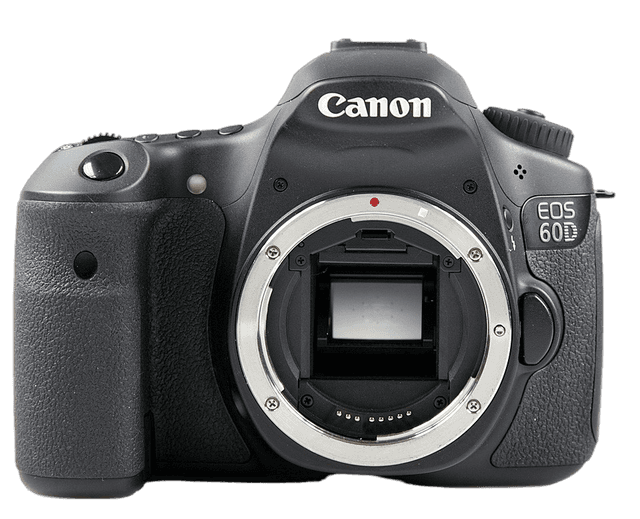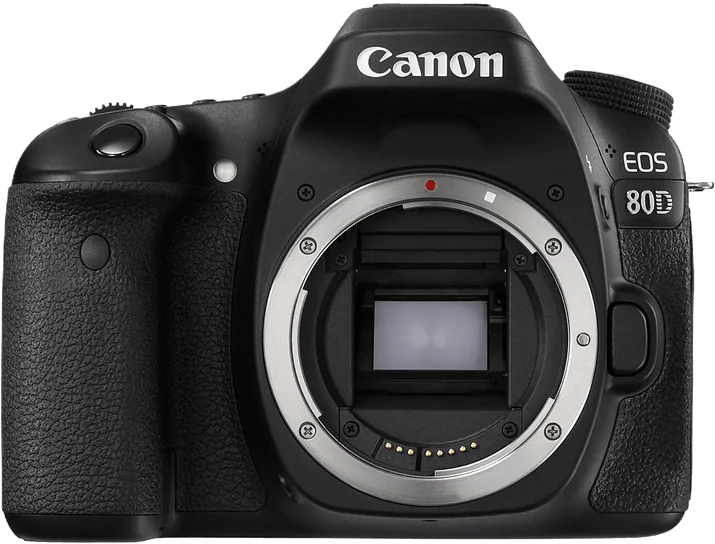Canon EOS 60D vs EOS 80D Comparison
Canon EOS 60D

Canon EOS 80D

The Canon EOS 80D triumphs over the Canon EOS 60D with a score of 64/100 compared to the latter’s 47/100. Both cameras share similarities as DSLRs, having the same launch price of around $1200 and nearly identical camera sizes. However, the 80D outperforms the 60D with its more recent release in 2016, six years after the 60D’s 2010 debut. Additionally, the 80D is slightly lighter at 730g, making it more convenient for users.
Despite the 60D’s lower score, it still has a larger width, measuring 145mm compared to the 80D’s 139mm. This size difference may appeal to some users. Ultimately, the Canon EOS 80D’s higher score and updated features make it a better choice for most photographers, while the 60D’s larger size may attract a specific niche of users.
Canon EOS 60D vs EOS 80D Overview and Optics
The Canon EOS 80D emerges as the winner in optics, with a score of 63/100 compared to the Canon EOS 60D’s score of 43/100. Both cameras share common specifications, such as the CMOS sensor type, APS-C sensor size, Canon EF-S lens mount, and the absence of image stabilization.
The EOS 80D’s superiority is evident in its higher megapixel count of 24.2, compared to the 60D’s 18 megapixels. This difference allows for more detailed and sharper images. Additionally, the 80D has a faster shooting speed of 7 frames per second (fps), compared to the 60D’s 5.3 fps, enabling the capture of fast-moving subjects with greater ease. The 80D also boasts a more advanced Digic 6 processor, which enhances image quality and processing speed, as well as a higher DXOMARK sensor score of 79, compared to the 60D’s Digic 4 processor and sensor score of 66.
The Canon EOS 60D, however, does not offer any significant advantages over the EOS 80D in terms of optics. Its lower score reflects its inferior specifications in comparison to the 80D.
Taking into consideration the aforementioned points, the Canon EOS 80D is the clear choice for those seeking better optical performance. With its higher megapixel count, faster shooting speed, and more advanced processor, the 80D is better equipped to deliver superior image quality and performance compared to the Canon EOS 60D.
Canon EOS 60D vs EOS 80D Video Performance
The Canon EOS 80D takes the lead in video capabilities, scoring 70/100, compared to the Canon EOS 60D’s score of 43/100. Both cameras share some common specifications, such as Full HD maximum video resolution and 1920 x 1080 maximum video dimensions. However, the Canon EOS 80D outperforms the 60D in several aspects of video performance.
One of the major advantages of the EOS 80D over the 60D is its maximum video frame rate. The EOS 80D can shoot at 60fps, while the 60D can only reach 30fps. This difference allows the 80D to capture smoother and more detailed motion, making it more suitable for fast-paced action or sports videography.
Additionally, the Canon EOS 80D has built-in time-lapse functionality, offering more creative options for video enthusiasts. This feature enables users to capture stunning time-lapse sequences without the need for additional equipment or software, making it more convenient and versatile for various video projects.
While the Canon EOS 60D does not excel in these areas, it may still be a sufficient choice for casual video users or photographers who prioritize still image quality over video performance. The lower video score should not deter those who do not require advanced video capabilities or higher frame rates.
In comparing the video capabilities of the Canon EOS 60D and the Canon EOS 80D, it is clear that the 80D is the superior choice for those seeking advanced video features and smoother motion capture. However, the 60D may still be a viable option for those with less demanding video needs. Ultimately, the choice between these two cameras depends on the specific requirements and preferences of the user.
Canon EOS 60D vs EOS 80D Features and Benefits
The Canon EOS 80D emerges as the winner with a feature score of 70/100, while the Canon EOS 60D trails behind with a score of 57/100. Both cameras share some common specifications, such as a 3-inch screen size and a screen resolution of 1,040,000 dots. Additionally, both cameras have flip screens, but neither has GPS or Bluetooth capabilities.
The Canon EOS 80D outshines the 60D in two major aspects. Firstly, the 80D boasts a touchscreen, providing users with greater convenience and ease of use when navigating menus and settings. Secondly, the 80D features built-in Wi-Fi, allowing users to effortlessly transfer images and remotely control the camera using a smartphone or tablet. These enhancements significantly contribute to the 80D’s higher feature score and make it a more user-friendly and versatile camera.
On the other hand, the Canon EOS 60D does not offer any significant advantages over the 80D, as it lacks both a touchscreen and Wi-Fi capabilities. Its lower feature score reflects these missing elements, making it a less appealing option for those seeking modern conveniences and connectivity options.
Taking into account the shared specifications and the additional features found in the 80D, it becomes clear that the Canon EOS 80D is the superior camera. Its touchscreen and Wi-Fi capabilities provide users with a more seamless and enjoyable photography experience, while the 60D falls short in these areas. Therefore, the Canon EOS 80D is the better choice for photographers seeking a camera with advanced features, connectivity, and ease of use.
Canon EOS 60D vs EOS 80D Storage and Battery
The Canon EOS 60D edges out the Canon EOS 80D in the storage and battery category, scoring 45/100 compared to the 80D’s 43/100. Both cameras share similarities in this aspect, such as having a single memory card slot and accepting SD, SDHC, and SDXC memory cards. Neither camera offers USB charging.
The 60D’s advantage lies in its longer battery life, providing 1100 shots compared to the 80D’s 960 shots. Both cameras use the LP-E6 battery type, ensuring compatibility between the two models. The 80D, however, supports the faster UHS-I SD cards, allowing for quicker file transfer and potentially better performance when capturing high-resolution images or video.
Despite the 80D’s advantage in memory card performance, the 60D’s longer battery life contributes to its slightly higher score in the storage and battery category. Users who prioritize battery life may prefer the 60D, while those who value faster memory card speeds might opt for the 80D.
Canon EOS 60D vs EOS 80D – Our Verdict
Are you still undecided about which camera is right for you? Have a look at these popular comparisons that feature the Canon EOS 60D or the Canon EOS 80D:

